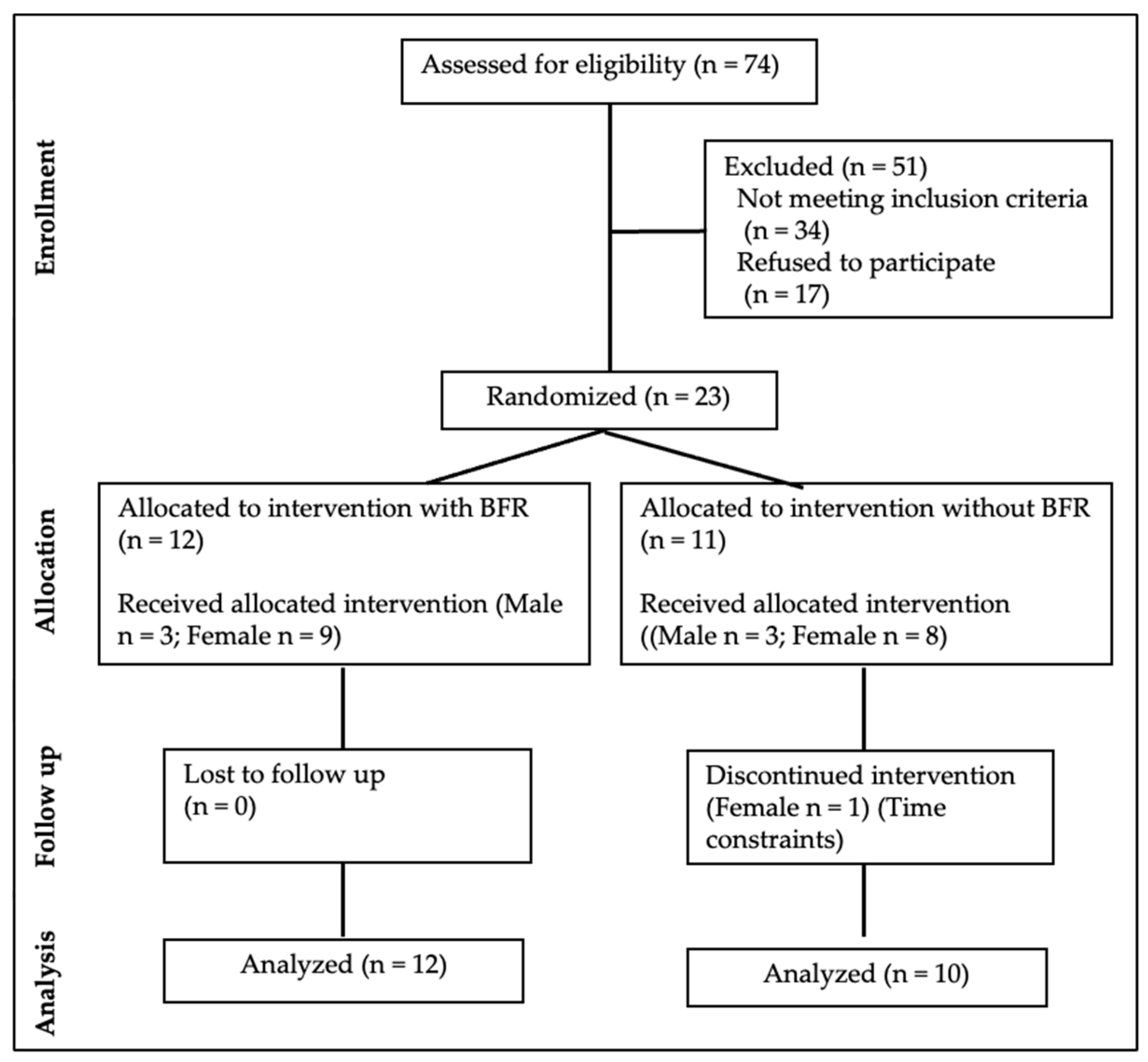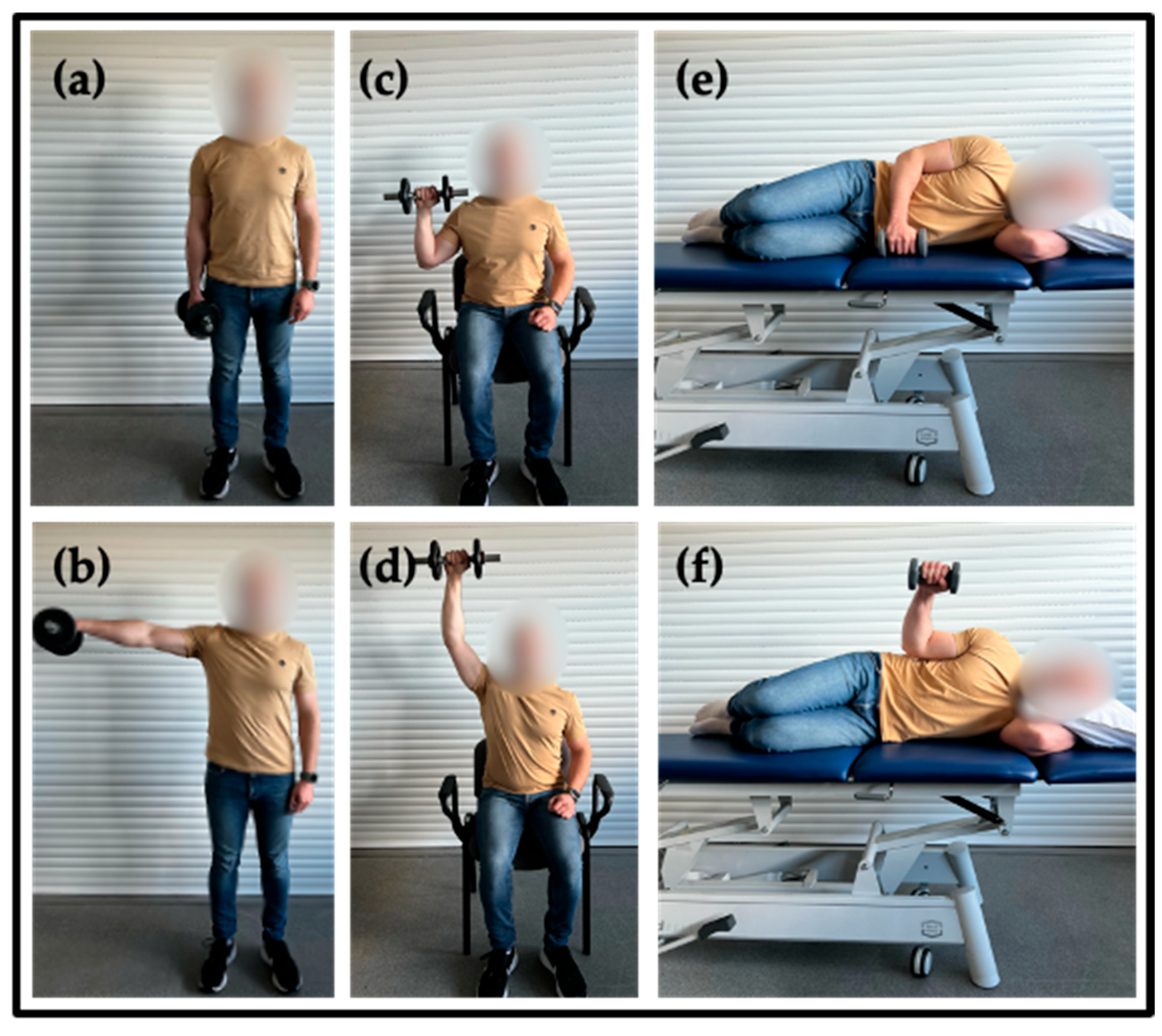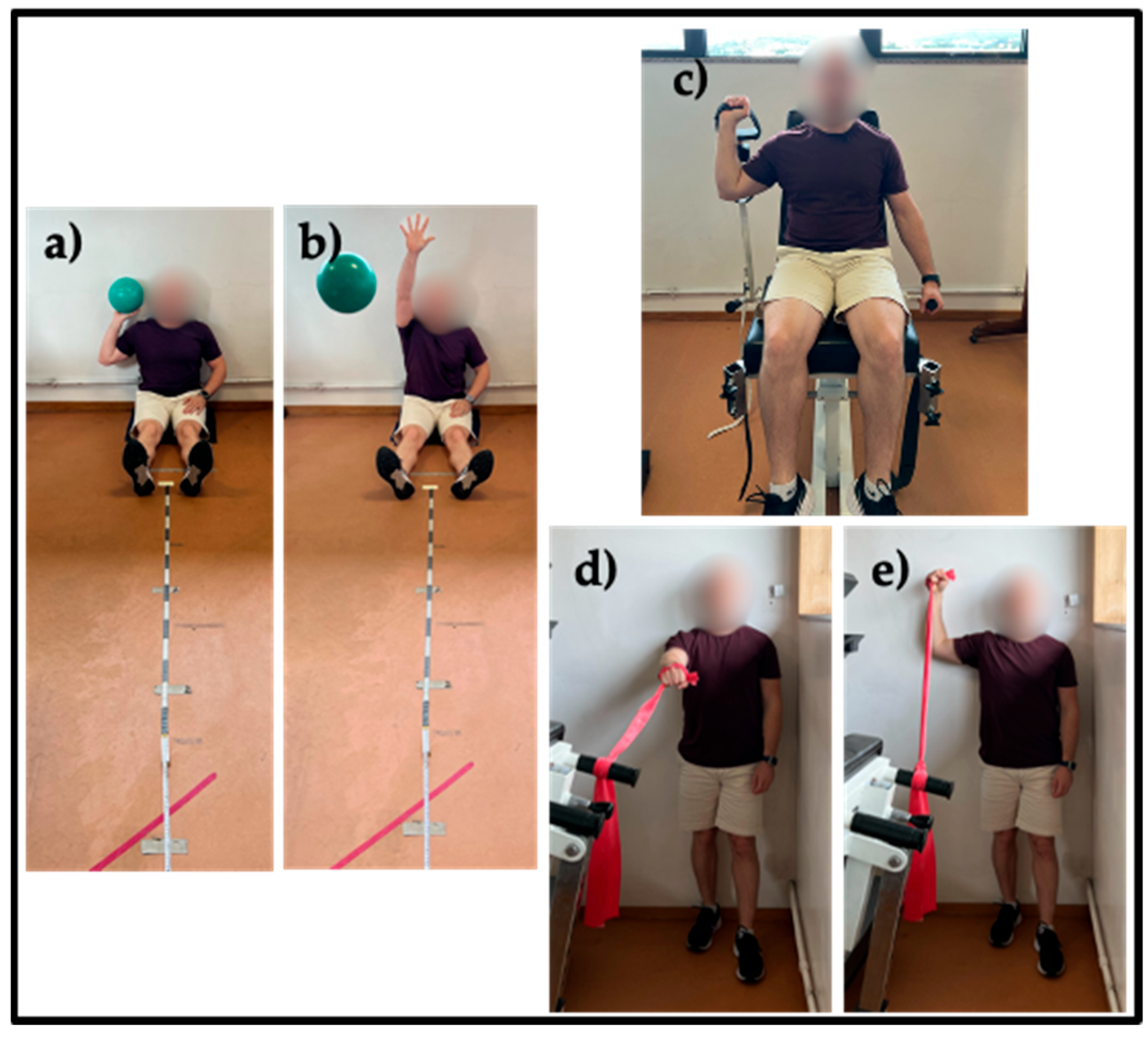Comparative Effects of Blood Flow Restriction and Traditional Strength Training on Proximal Shoulder Musculature: A Randomized Clinical Trial
Abstract
1. Introduction
2. Results
3. Discussion
4. Materials and Methods
4.1. Study Design
4.2. Sample
4.3. Procedures
4.3.1. Training Protocol
- (1)
- Performed in a standing position, raising the upper limb to 90° of abduction and then returning to the starting position. (Figure 2a,b).
- (2)
- Dumbbell Overhead Press: Executed seated with back support. Weight was elevated vertically from shoulder level to above the head and returning (Figure 2c,d).
- (3)
- Shoulder Lateral Rotation: Performed lying on a bench. Participant was seated with the arm resting against the torso and the elbow flexed at 90°. The movement involved performing shoulder external rotation (Figure 2e,f).
Determination of Blood Flow Restriction Pressure (BFR)
4.3.2. Data Collection
Arm Circumference
Muscle Power
Vertical Lift Strength
Shoulder Endurance Test
4.3.3. Data Analysis
5. Conclusions
Author Contributions
Funding
Institutional Review Board Statement
Informed Consent Statement
Data Availability Statement
Acknowledgments
Conflicts of Interest
Correction Statement
Abbreviations
| BFR | Blood Flow Restriction |
| BMI | Body Mass Index |
| SASPT | Single Arm Seated Shot-Put Test |
| SET | Shoulder Endurance Test |
| VLS | Vertical Lift Strength |
References
- Ratamess, N.A.; Alvar, B.A.; Evetoch, T.K.; Housh, T.J.; Kibler, W.B.; Kraemer, W.J.; Triplett, N.T.; American College of Sports Medicine. Progression models in resistance training for healthy adults. Med. Sci. Sports Exerc. 2009, 41, 687–708. [Google Scholar] [CrossRef]
- Jacquier-Bret, J.; Gorce, P. Prevalence of Body Area Work-Related Musculoskeletal Disorders among Healthcare Professionals: A Systematic Review. Int. J. Environ. Res. Public Health 2023, 20, 841. [Google Scholar] [CrossRef]
- Tooth, C.; Gofflot, A.; Schwartz, C.; Croisier, J.L.; Beaudart, C.; Bruyere, O.; Forthomme, B. Risk Factors of Overuse Shoulder Injuries in Overhead Athletes: A Systematic Review. Sports Health 2020, 12, 478–487. [Google Scholar] [CrossRef]
- Bowman, E.N.; Elshaar, R.; Milligan, H.; Jue, G.; Mohr, K.; Brown, P.; Watanabe, D.M.; Limpisvasti, O. Upper-extremity blood flow restriction: The proximal, distal, and contralateral effects—A randomized controlled trial. J. Shoulder Elb. Surg. 2020, 29, 1267–1274. [Google Scholar] [CrossRef] [PubMed]
- Sato, Y. The history and future of KAATSU Training. Int. J. KAATSU Train. Res. 2005, 1, 1–5. [Google Scholar] [CrossRef]
- Pearson, S.J.; Hussain, S.R. A review on the mechanisms of blood-flow restriction resistance training-induced muscle hypertrophy. Sports Med. 2015, 45, 187–200. [Google Scholar] [CrossRef]
- Guedria, M.; Besson, C.; Millet, G.P.; Gremeaux, V. Exercise training with blood flow restriction: Mechanisms and applications. Rev. Med. Suisse 2022, 18, 1464–1469. [Google Scholar] [CrossRef]
- Patterson, S.D.; Leggate, M.; Nimmo, M.A.; Ferguson, R.A. Circulating hormone and cytokine response to low-load resistance training with blood flow restriction in older men. Eur. J. Appl. Physiol. 2013, 113, 713–719. [Google Scholar] [CrossRef]
- Loenneke, J.P.; Kim, D.; Fahs, C.A.; Thiebaud, R.S.; Abe, T.; Larson, R.D.; Bemben, D.A.; Bemben, M.G. Effects of exercise with and without different degrees of blood flow restriction on torque and muscle activation. Muscle Nerve 2015, 51, 713–721. [Google Scholar] [CrossRef] [PubMed]
- Pavlou, K.; Korakakis, V.; Whiteley, R.; Karagiannis, C.; Ploutarchou, G.; Savva, C. The effects of upper body blood flow restriction training on muscles located proximal to the applied occlusive pressure: A systematic review with meta-analysis. PLoS ONE 2023, 18, e0283309. [Google Scholar] [CrossRef]
- Lambert, B.; Hedt, C.; Daum, J.; Taft, C.; Chaliki, K.; Epner, E.; McCulloch, P. Blood Flow Restriction Training for the Shoulder: A Case for Proximal Benefit. Am. J. Sports Med. 2021, 49, 2716–2728. [Google Scholar] [CrossRef]
- SmartToolsPlus. Smartcuffs PRO—USER MANUAL. 2020. Available online: https://manuals.plus/smart/cuffs-pro-manual (accessed on 1 July 2025).
- Wilson, J.M.; Lowery, R.P.; Joy, J.M.; Loenneke, J.P.; Naimo, M.A. Practical blood flow restriction training increases acute determinants of hypertrophy without increasing indices of muscle damage. J. Strength Cond. Res. 2013, 27, 3068–3075. [Google Scholar] [CrossRef]
- Dankel, S.J.; Jessee, M.B.; Abe, T.; Loenneke, J.P. The Effects of Blood Flow Restriction on Upper-Body Musculature Located Distal and Proximal to Applied Pressure. Sports Med. 2016, 46, 23–33. [Google Scholar] [CrossRef]
- Cook, S.B.; Clark, B.C.; Ploutz-Snyder, L.L. Effects of exercise load and blood-flow restriction on skeletal muscle function. Med. Sci. Sports Exerc. 2007, 39, 1708–1713. [Google Scholar] [CrossRef]
- Hughes, L.; Paton, B.; Rosenblatt, B.; Gissane, C.; Patterson, S.D. Blood flow restriction training in clinical musculoskeletal rehabilitation: A systematic review and meta-analysis. Br. J. Sports Med. 2017, 51, 1003–1011. [Google Scholar] [CrossRef]
- Safford, D.W.; Shah, K.M.; Breidenbach, F.; McClure, P.W. Effects of Low-Load Blood Flow Restriction Training on Rotator Cuff Strength and Hypertrophy: Case Series. Int. J. Sports Phys. Ther. 2024, 19, 735–744. [Google Scholar] [CrossRef]
- Yasuda, T.; Fujita, S.; Ogasawara, R.; Sato, Y.; Abe, T. Effects of low-intensity bench press training with restricted arm muscle blood flow on chest muscle hypertrophy: A pilot study. Clin. Physiol. Funct. Imaging 2010, 30, 338–343. [Google Scholar] [CrossRef]
- Fatela, P.; Mendonca, G.V.; Veloso, A.P.; Avela, J.; Mil-Homens, P. Blood Flow Restriction Alters Motor Unit Behavior During Resistance Exercise. Int. J. Sports Med. 2019, 40, 555–562. [Google Scholar] [CrossRef] [PubMed]
- Liu, H.; Jiang, L.; Wang, J. The effects of blood flow restriction training on post activation potentiation and upper limb muscle activation: A meta-analysis. Front. Physiol. 2024, 15, 1395283. [Google Scholar] [CrossRef]
- Schoenfeld, B.J.; Ogborn, D.; Pinero, A.; Burke, R.; Coleman, M.; Rolnick, N. Fiber-Type-Specific Hypertrophy with the Use of Low-Load Blood Flow Restriction Resistance Training: A Systematic Review. J. Funct. Morphol. Kinesiol. 2023, 8, 51. [Google Scholar] [CrossRef]
- Bowman, E.N.; Elshaar, R.; Milligan, H.; Jue, G.; Mohr, K.; Brown, P.; Watanabe, D.M.; Limpisvasti, O. Proximal, Distal, and Contralateral Effects of Blood Flow Restriction Training on the Lower Extremities: A Randomized Controlled Trial. Sports Health 2019, 11, 149–156. [Google Scholar] [CrossRef]
- Del Vecchio, A.; Casolo, A.; Negro, F.; Scorcelletti, M.; Bazzucchi, I.; Enoka, R.; Felici, F.; Farina, D. The increase in muscle force after 4 weeks of strength training is mediated by adaptations in motor unit recruitment and rate coding. J. Physiol. 2019, 597, 1873–1887. [Google Scholar] [CrossRef]
- Centner, C.; Lauber, B. A Systematic Review and Meta-Analysis on Neural Adaptations Following Blood Flow Restriction Training: What We Know and What We Don’t Know. Front. Physiol. 2020, 11, 887. [Google Scholar] [CrossRef]
- Green, L.L.; Cupp, J.L.; Cole, E.; Craig, D.; Crawford, K.; Hogan, S.; Holsted, J.; Lovell, H.; Sarna, M. Investigating Strength Effects at the Shoulder Using Blood Flow Restriction. Ann. Physiother. Occup. Ther. 2020, 3, 1–6. [Google Scholar] [CrossRef]
- Lecce, E.; Amoruso, P.; Vecchio, A.D.; Casolo, A.; Felici, F.; Farina, D.; Bazzucchi, I. Neural determinants of the increase in muscle strength and force steadiness of the untrained limb following a 4 week unilateral training. J. Physiol. 2025, 603, 3605–3630. [Google Scholar] [CrossRef]
- Reece, T.M.; Godwin, J.S.; Strube, M.J.; Ciccone, A.B.; Stout, K.W.; Pearson, J.R.; Vopat, B.G.; Gallagher, P.M.; Roberts, M.D.; Herda, T.J. Myofiber hypertrophy adaptations following 6 weeks of low-load resistance training with blood flow restriction in untrained males and females. J. Appl. Physiol. 2023, 134, 1240–1255. [Google Scholar] [CrossRef]
- Cuschieri, S. The CONSORT statement. Saudi J. Anaesth. 2019, 13, S27–S30. [Google Scholar] [CrossRef]
- Suga, T.; Okita, K.; Morita, N.; Yokota, T.; Hirabayashi, K.; Horiuchi, M.; Takada, S.; Takahashi, T.; Omokawa, M.; Kinugawa, S.; et al. Intramuscular metabolism during low-intensity resistance exercise with blood flow restriction. J. Appl. Physiol. 2009, 106, 1119–1124. [Google Scholar] [CrossRef]
- Roehl, T.; Lambert, B.S.; Ankersen, J.; Hernandez, K.; McCulloch, P.C.; Hedt, C. Optimal Blood Flow Restriction Occlusion Pressure for Shoulder Muscle Recruitment With Upper Extremity Exercise. Am. J. Sports Med. 2023, 51, 1859–1871. [Google Scholar] [CrossRef]
- Riemann, B.L.; Johnson, W.; Murphy, T.; Davies, G.J. A Bilateral Comparison of the Underlying Mechanics Contributing to the Seated Single-Arm Shot-Put Functional Performance Test. J. Athl. Train. 2018, 53, 976–982. [Google Scholar] [CrossRef]
- Sousa, A.C.; Marques, D.L.; Calado, A.M.; Pacheco, C.; Marinho, D.A.; Marques, M.C.; Travassos, B.F. Validity and Reliability of The Smart Groin Trainer for Measuring Hip Adduction Strength. J. Hum. Kinet. 2022, 82, 51–59. [Google Scholar] [CrossRef]
- Decleve, P.; Van Cant, J.; Attar, T.; Urbain, E.; Marcel, M.; Borms, D.; Cools, A.M. The shoulder endurance test (SET): A reliability and validity and comparison study on healthy overhead athletes and sedentary adults. Phys. Ther. Sport 2021, 47, 201–207. [Google Scholar] [CrossRef]



| BFR Group (n = 12) | High-Load Group (n = 10) | p | ||
|---|---|---|---|---|
| N (%) | N (%) | |||
| Sex | Female | 9 (75) | 7 (70) | 0.583 a |
| Male | 3 (25) | 3 (30) | ||
| x̅ ± sd (min–max) | x̅ ± sd (min–max) | |||
| Age (years) | 22.3 ± 1.6 (19–25) | 22.6 ± 2.1 (20–26) | 0.659 b | |
| BMI * (kg/m2) | 23.5 (1.9) | 22.4 (4.2) | 0.598 c | |
| M0 | M1 | |||||
|---|---|---|---|---|---|---|
| BFR Group | High-Load Group | BFR Group | High-Load Group | |||
| x̅ ± sd | p | x̅ ± sd | p | |||
| ArmC (cm) | 31.97 ± 2.02 | 31.92 ± 4.05 | 0.974 a | 32.91 ± 2.41 | 32.49 ± 3.23 | 0.270 a |
| SASSPT (cm) * | 250.00 (83) | 247.50 (99) | 0.273 b | 280.00 (93) | 269.50 (110) | 0.531 b |
| VLS (kg) | 18.95 ± 7.45 | 19.22 ± 9.74 | 0.942 a | 24.47 ± 9.73 | 24.10 ± 12.71 | 0.406 a |
| SET (s) | 62.08 ± 12.73 | 59 ± 13.47 | 0.588 a | 95.67 ± 31.33 | 78.50 ± 22.25 | 0.303 a |
| BFR Group (n = 12) | High-Load Group (n = 10) | |||||
|---|---|---|---|---|---|---|
| M1−M0 x̅ ± sd | p a | Cohen’s d | M1−M0 x̅ ± sd | p a | Cohen’s d | |
| ArmC (cm) | 0.94 ± 1.08 | 0.012 | 0.870 | 0.57 ± 1.25 | 0.182 | 0.457 |
| SASSPT (cm) | 19.67 ± 16.98 | 0.002 | 1.158 | 22.00 ± 22.88 | 0.014 | 0.962 |
| VLS (kg) | 5.52 ± 4.30 | <0.001 | 1.284 | 4.88 ± 5.30 | 0.017 | 0.922 |
| SET (s) | 33.58 ± 25.82 | <0.001 | 1.301 | 19.50 ± 15.76 | 0.004 | 1.238 |
Disclaimer/Publisher’s Note: The statements, opinions and data contained in all publications are solely those of the individual author(s) and contributor(s) and not of MDPI and/or the editor(s). MDPI and/or the editor(s) disclaim responsibility for any injury to people or property resulting from any ideas, methods, instructions or products referred to in the content. |
© 2025 by the authors. Licensee MDPI, Basel, Switzerland. This article is an open access article distributed under the terms and conditions of the Creative Commons Attribution (CC BY) license (https://creativecommons.org/licenses/by/4.0/).
Share and Cite
Ghionna, L.; Ruppel, L.; Nogueira, N.; Brochado, G.; Carvalhais, A. Comparative Effects of Blood Flow Restriction and Traditional Strength Training on Proximal Shoulder Musculature: A Randomized Clinical Trial. Muscles 2025, 4, 34. https://doi.org/10.3390/muscles4030034
Ghionna L, Ruppel L, Nogueira N, Brochado G, Carvalhais A. Comparative Effects of Blood Flow Restriction and Traditional Strength Training on Proximal Shoulder Musculature: A Randomized Clinical Trial. Muscles. 2025; 4(3):34. https://doi.org/10.3390/muscles4030034
Chicago/Turabian StyleGhionna, Lucas, Léa Ruppel, Nuno Nogueira, Gabriela Brochado, and Alice Carvalhais. 2025. "Comparative Effects of Blood Flow Restriction and Traditional Strength Training on Proximal Shoulder Musculature: A Randomized Clinical Trial" Muscles 4, no. 3: 34. https://doi.org/10.3390/muscles4030034
APA StyleGhionna, L., Ruppel, L., Nogueira, N., Brochado, G., & Carvalhais, A. (2025). Comparative Effects of Blood Flow Restriction and Traditional Strength Training on Proximal Shoulder Musculature: A Randomized Clinical Trial. Muscles, 4(3), 34. https://doi.org/10.3390/muscles4030034







